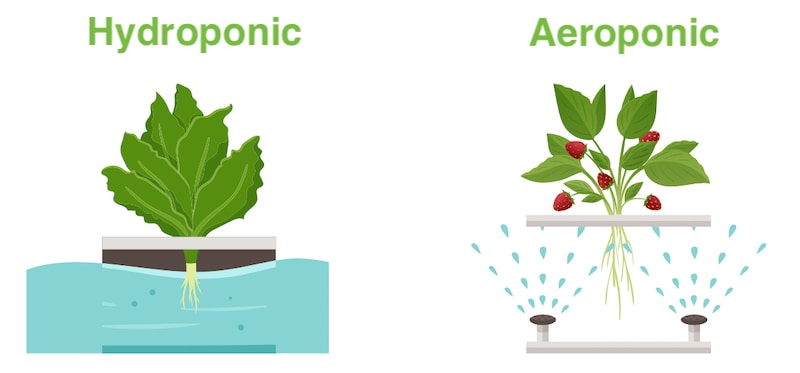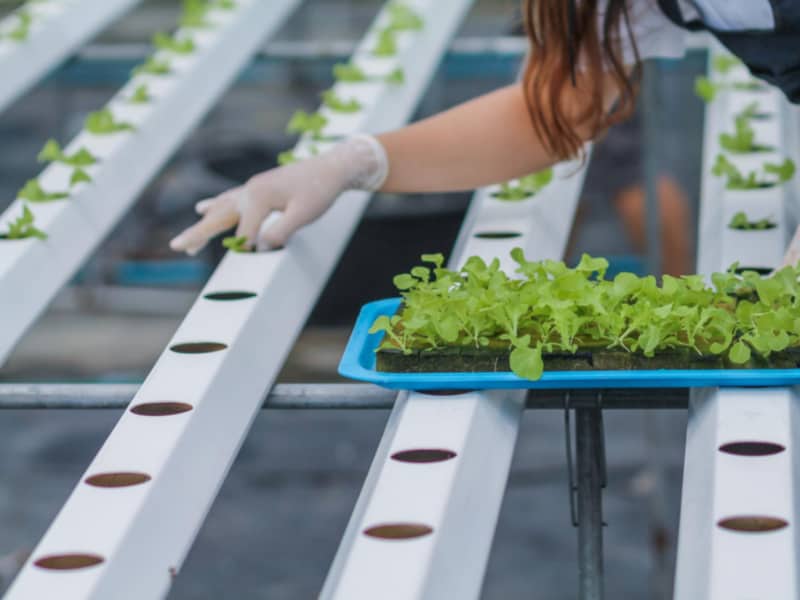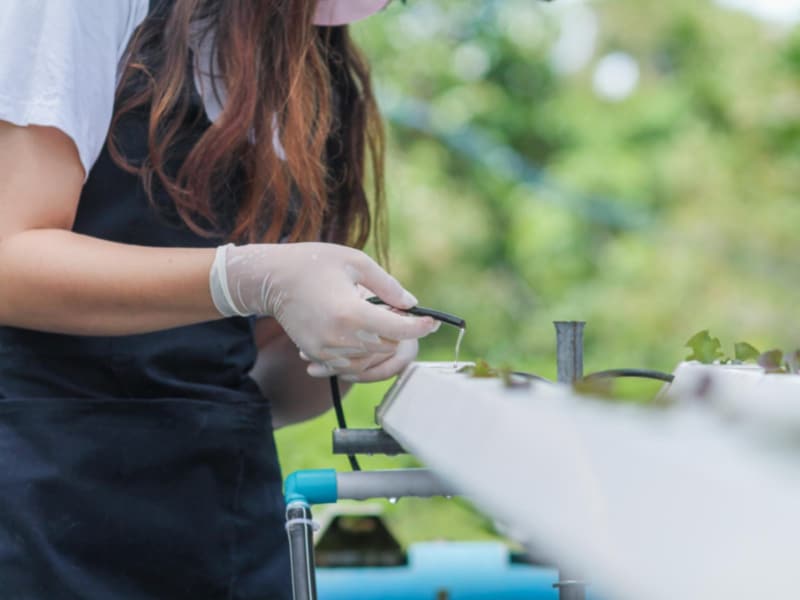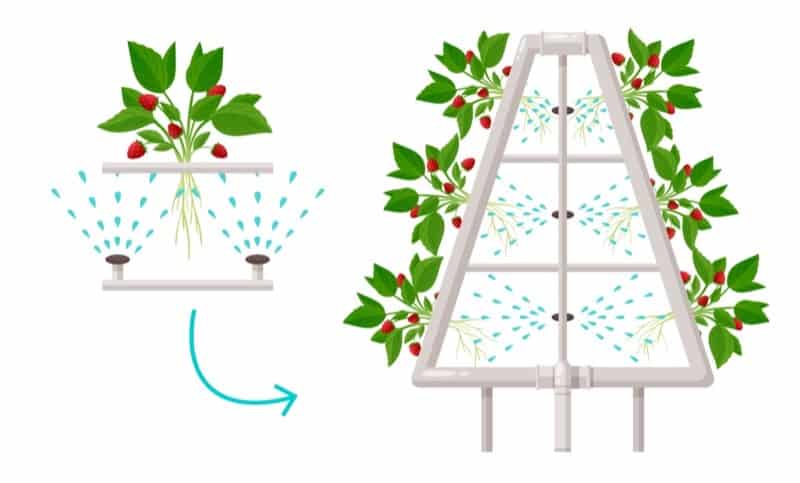There are a variety of systems to grow plants out there and picking which path is best for you isn’t always the easiest.
I take a look at two of the more popular and innovative ways for gardeners to grow plants: Hydroponics vs Aeroponics.
I’ll look at the similarities and differences between hydroponics and aeroponics, from initial costs, categories of plants that are good to grow, ongoing costs, maintenance times, environmental impact, and more.
What is Hydroponics?
Hydroponics is a soilless method of growing plants. Using this method, hydroponic plants are grown in a grow medium like rock wool, gravel, liquid, or coconut husks. They are always getting a nutrient-rich water solution because the roots are always underwater.
Most types of hydroponic systems are designed for indoors and use grow lights that are designed to mimic natural sunlight.
In hydroponics gardening, the nutrient delivery system means it is possible to have precise control over nutrient levels for improved plant health.
Using these methods, it’s possible for hydroponics systems to produce yields that are 30% to 40% greater than traditional gardening methods.

What is Aeroponics?
Aeroponics is a type of hydroponics that doesn’t use a growing medium like other forms of hydroponics. The roots are left exposed to the air with aeroponic gardens.
The air and root system are kept moist by a mist of water, this nutrient-rich mist is constantly fed to the roots through special misting nozzles.
In aeroponic systems, the roots of plants can grow without any constraints from a growing medium. This leads to faster plant growth than with any soil-based farming or gardening techniques, and arguably also gives it an edge over common forms of hydroponics, like Deep Water Culture systems.
There are various aeroponic system types, however they all share common features. The plants are grown without any growth medium as plant roots are suspended in a dark enclosure.
There are low and high-pressure aeroponic systems that differ on the pressure levels used to create the fine mist. Pressure from spray nozzles will mist plant roots with nutrient-rich water solution.
4 Similarities Between Hydroponics vs Aeroponics
Let’s first take a look at the common similarities between aeroponics and hydroponics when it comes to features and benefits.
No matter the size range, home to commercial use, the benefits of both systems are consistent for both hobby gardeners and large farms.
1. Increased Plant Yields
On average, most hydroponics and aeroponics show an increase of crop yields of between 30% and 40% over traditional farming methods.
Both methods supply precise amounts of nutrients straight to the plant roots in regular intervals. As a result, nutrient absorption is higher. This means that the plants are always fed the exact amount they require for optimal growth and improved plant health.
With soil gardening, much of the food is lost to the environment or consumed by microbes and weeds that share the soil growing medium.
Healthy growth is also supported by a great reduction in the amount of microbes and pests that are more prominent in traditional soil growing methods. In any Hydroponics or Aeroponics system, insect infestations are greatly reduced, which makes for stronger plants.
Plants grown in soil-free cultivation systems also benefit from, in most cases, artificial grow lights. These lights directly mimic the sun’s natural light and that allows the plants always have the light they need to flourish.
2. Environmentally Friendly
Water recycling and water conservation are at the top of the list with being eco-friendly. There is little unused water as both hydroponics and aeroponics are highly water efficient.
Despite using reservoir tanks to hold a large water supply, gallons of water, these systems use up to 90% less water than traditional growing methods.
This reduction in water waste is down to the fact that the water is constantly recycled with the plants only taking what they need, water evaporation is the only source of water loss.
The use of nutrients and insecticides is also minimized. Because the nutrients can be precisely targeted and measured far less is needed than when grown in soil. Similarly, because pest infestations are lower, then the need to use chemical insecticides is greatly reduced.

3. Grow All Year Round
Unlike outdoor gardening where the seasons dictate what you can grow, one substantial advantage that these kinds of systems offer is the ability to grow plants all year round.
With the use of grow lights and the ability to control environmental factors like temperature and humidity, you can literally grow strawberries in the middle of winter.
When paired with the improved yields that these systems offer, this means you can enjoy ample amounts of fresh fruit, vegetables, and herbs all year round.
- Related article: How to Grow Herbs Without Sunlight Indoors
4. Cost Effective
Despite electricity costs from running lights and pumps, and the cost of nutrient solution, these are still cost-effective systems. When you account for the increase in crop yield, all year round grow times, and the water efficiency of the systems, then these systems quickly pay for themselves.
Most lighting systems now use low-wattage LED lights which produce a lot of light and use less electricity than earlier systems.
10 Differences Between Aeroponics vs Hydroponics
Whilst there are many similarities between the methods, there are also some critical differences between the two. In this section, I will cover the areas where these differences occur and will select a winner in each section.
1. Plant Yields
Both aeroponics and hydroponics provide far higher yields than traditional gardening methods, but a considerable advantage of aeroponics is a higher yield of plants.
Aeroponics delivers nutrient-rich solution directly to the roots of the plant in with water droplets in the mist. Roots are able to grow unencumbered and results in better yields than with traditional hydroponic systems.
With aeroponics, exposure to the air provides roots with oxygen consistently and potentially speeds up plant growth.
In hydroponics, the roots are in water, reducing the amount of oxygen they receive. The plants in water reservoirs will need submersible water pumps to create oxygen for the roots. With a hydroponic garden, the roots are more restrained by the growing medium and this can restrict the plant growth.
Winner – Plant yields are one area where aeroponics has the edge over hydroponics. The growing medium for hydroponics is more restricting than aeroponics, but still better than traditional soil.
2. Root Health
Keeping plant roots healthy is vital for plant growth and delivery of nutrients. They absorb and store the water and nutrients for plants.
Just like humans, roots breathe oxygen and release carbon-dioxide. As mentioned above, the aeroponic method allows this to happen by keeping the roots exposed to air, this helps keep the root system strong and healthy.
While hydroponics submerge roots with water, aeroponics let the roots hang in the air for direct access to oxygen. The roots are submerged in the nutrient-filled water.
One shortcoming of hydroponics is it’s more prone to root rot and root diseases, because the roots are stagnant, sitting in the same water reservoir. Water-based diseases can quickly affect the whole crop. That’s why it’s important to have water cycles with continuous pumping, especially for larger water tanks.
Aeroponics delivers nutrient water in mist form, so the water molecules are never stagnant. The roots are kept in dark enclosures to prevent light exposure, which can harm the roots.
Winner – Aeroponics nudges out the win again. Even though root problems are rare in any type of well-maintained system, Aeroponic systems are less-prone to this type of problem.
3. Setup and Ongoing Costs
Generally, hydroponics are simpler, less expensive systems than aeroponics. Despite having the additional cost of a growing medium, these systems are cheaper to install and run than aeroponics.
The equipment difference between hydroponics and aeroponics can be significant. A simple household hydroponics kit is no more than a water reservoir, an air pump, a grow tray, and a lighting system.
With Aeroponics, there is the additional cost of specialized nozzles, delivery pipes, and some kind of dark enclosure for the roots. Aeroponics are also usually larger systems. I haven’t’ seen any countertop versions because of the more specialized, sensitive equipment needed to create the mist.
Ongoing costs are similar for both systems, but the regular system maintenance costs for aeroponics can be higher due to having more equipment. Hydroponics can be more cost efficient, because there aren’t as many extra costs, nor potential long-term costs.
Winner – With startup and ongoing costs, hydroponic systems are the winner here. They are cheaper to set up, simpler, and less moving parts that’ll require maintenance.
4. Plant Disease Prevalence
Disease can strike any system, water or soil-based. Any form of hydroponics and aeroponics can run into plant disease, but when it comes to comparing the two systems, then aeroponics has the edge.
Traditional Hydroponics feed the plants from a shared water reservoir, so any water-borne diseases that occur are likely to affect the whole crop.
With aeroponic setups, the risk of disease is lessened as the nutrient delivery as mist has less chance of spread of disease.
Winner – When considering disease prevalence, the winner here is aeroponics.

5. Maintenance
Hydroponic systems are easier to maintain and run with water lines, pipes, and/or tanks. You’ll need to check on water levels, water temperature, and more.
With aeroponic systems, more care, time, and constant attention are required on an ongoing basis. Without a growing medium to act as a buffer, water acidity levels (pH levels) can swing more.
Maintaining the correct pH level is crucial to plant health, because too low or high levels will slow plant growth.
The best pH level for hydroponics varies based on plants, but most plants like a pH level of 5.5 to 6.5 for aeroponics, while hydroponics are 5.5 to 6.0.
The nutrient levels are also more sensitive. In traditional hydroponics, the nutrients are absorbed by the growing medium and can act as a buffer to smooth over times when the nutrient levels may not be at their optimum.
In aeroponics, there is no buffer, so it’s even more important to keep an eye on the nutrient solution being sprayed. There is also the extra need of checking of the plumbing of the water supply pipes, and the special nozzles need to be for mineral buildup that can cause blockages and bacterial growth.
Winner – Hydroponics is the clear winner in this category. Aeroponics are more complex and challenging systems, so they need special attention and monitoring. By no means are hydroponic systems maintenance-free, but they are certainly easier to maintain.
6. Electricity Supply
Both of these plant setups for growing require a stable electricity supply for the equipment. Pumps and lights need plenty of electricity to be constantly running to keep the plants fed and healthy.
One of the advantages of hydroponics stands out there. If there was a power failure, the growing medium (e.g., foam sheets) can help keep the plants watered, because the mediums also absorb and hold a supply of water. Those smaller quantities of water give you ample time to fix the power.
There is no growing medium in an aeroponic garden, they rely on the mist for water and nutrients. The plants require the constant mist supplied by the specialized equipment to keep them alive. Any power outage instantly cuts this off and with no cushion of a growing medium, the plants will quickly suffer.
Most serious aeroponic farms will have a back-up power supply to continue providing food for plants.
Winner – In the event of a power failure, hydroponic setups win here.
7. Complexity
Both these systems have the potential to become very complex depending on how large they are. But if you compare similar-size aeroponics and hydroponics gardens, then hydroponics will always be less complex.
Aeroponics, with its requirements of extra plumbing, nozzles and other extra equipment. As one example, because roots are exposed to the air and not secured like plants in hydroponics systems, there are special aeroponics clips to secure individual plant roots.
Winner – For beginners wanting to start simple and learn the ropes of hydroponics, then a traditional hydroponic system is the way to go. These types of system are far less complex and have a smaller learning curve.
8. Space Requirements
These are both great systems for growing in small spaces, but their setups do vary.
With aeroponics, it is easier to set up plant stacks that are “vertical farms.” Vertical gardens have more efficient space utilization. Mist and drip systems are easy to place numerous plants vertically, as long as you have ample space vertically.
These types of aeroponic systems means that the space available can be utilized far more efficiently than a hydroponic setup.
Hydroponics setups are horizontal, because of the need for a water reservoir and/or water lines.
Winner – For optimal use of space, aeroponics comes out on top here.
Check out this amazing, next gen aeroponics farm that saves 90% of water compared to traditional soil farming.
9. Plant Transplanting
When it comes to plant transplantation, aeroponic plants can be moved easily without affecting their health or disrupting their growth.
Because there is no growing medium which have bound the roots, the plants can simply be lifted with the collar they are grown in and moved to a new location. This helps to keep the whole growing area organized and means you can do things like move plants that need more light to a better position.
With hydroponics, this is not as feasible an option. The roots tend to bind to both the growing medium and they will “mat” with a neighboring plant’s roots.
Winner – For plant mobility, aeroponics allow you to more easily move plants around.
10. Water Usage
These are both highly-efficient systems when it comes to water usage. Both types of system compare favorably to traditional soil-based plant growing.
However, despite the fact that hydroponics is better for recycling water, aeroponics actually consume around 25% less water than similarly sized hydroponic systems.
Winner – Water with aeroponics wins this one, however it is important to note that both systems are environmentally friendly when it comes to water usage.

Final Thoughts Hydroponics and Aeroponics
These are both fantastic methods for producing year round, high-yield plants. When it comes to choosing an outright winner, then aeroponics would seem to have the edge. It’s less prone to disease, uses less water, produces higher yields, and is more space efficient.
However, let’s not forget that aeroponics is also higher-maintenance, more prone to failure, more complex, and more susceptible to power failures. More time and money is needed.
Hydroponics, is a better starting point for beginners. They are more forgiving, less complex, and easier and cheaper to set up. For green thumbs, hydroponics is the choice between the two. Something like an AeroGarden Bounty garden kit would be a great hydroponics indoor garden kit.
- Learn More: AeroGarden Bounty Garden Reviews
For advanced users already versed in the intricacies of hydroponics, then an aeroponic systems would be a great way to take the next step in your gardening journey.
Whichever way you decide to go, both aeroponics and hydroponics will provide you with year round, fresh produce that can be plucked straight from the plant and onto your plate.
New gardening technologies and concepts can be confusing. With Smart Garden & Home, I hope to break things down to make the information digestible.
Learn more about other growing methods:
FAQs – Frequently Asked Questions
Hydroponics vs Aeroponics – What’s the Difference?
The key differences between hydroponics and aeroponics is the way the roots get their water, nutrients, and oxygen. Traditional hydroponic systems submerge the roots in nutrient-rich water, so plant roots will be able to absorb water and nutrients when it needs. As the roots are always in water, air pumps are needed to create oxygen for the roots.
With aeroponic systems, roots are not submerged in water and hang in the air. Roots are spray misted with nutrient-rich water to receive the necessary water and nutrients. For oxygen, the plant roots always have a ready-supply available, because they’re exposed to the air.


